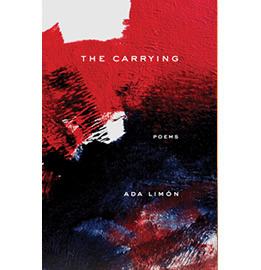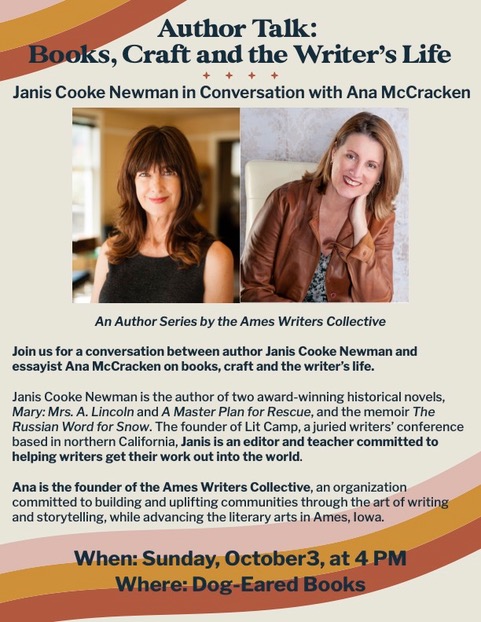What I am reading, but first…
Who knows if you want to read what I read this last semester in my MFA Program at Iowa State. My reading list felt endless with Gothic short stories for my Gothic Literature class, and essays about the Mythic West (The Essential West Collected Essays by Elliott West) and a book about Buffalo Bill Cody. At times I felt as if I was drowning in words. So many words. So many horror stories. And countless papers and a seminar paper to write. Trust me, I did my fair share of griping, moaning and crying.
 Buffalo Bill’s America – William Cody and The Wild West Show by Louis S. Warren is 549 pages long. That’s 224 pages over my 325-page-requirement for a book’s word count. Louis’ book, according to my study-buddy, Nancy, could have used an edit. He’s verbose. (I tilted the camera angle to prove with my Post-It notes that I read the book.) That said, it was quite interesting. The class for which I read it, History of the Mythic West taught by Iowa State University Professor Julie Courtwright is fascinating. All the assignments and reading aside, this class explained for me why America is in the predicament it is today. Don’t get me started on the history of this country’s despicable past.
Buffalo Bill’s America – William Cody and The Wild West Show by Louis S. Warren is 549 pages long. That’s 224 pages over my 325-page-requirement for a book’s word count. Louis’ book, according to my study-buddy, Nancy, could have used an edit. He’s verbose. (I tilted the camera angle to prove with my Post-It notes that I read the book.) That said, it was quite interesting. The class for which I read it, History of the Mythic West taught by Iowa State University Professor Julie Courtwright is fascinating. All the assignments and reading aside, this class explained for me why America is in the predicament it is today. Don’t get me started on the history of this country’s despicable past.
What surprised me most this semester, was this. Never in a million years did I believe that I am capable of writing a literary seminar paper. I have amnesia about writing critical essays in Mrs. Schmidt’s seventh grade English class at Thomas Jefferson in Peoria, Illinois. My friend Lori claims we wrote them. Somehow I survived Gothic Lit, which should be renamed in the course catalog as Gothic Criticism. (All we did besides reading Gothic short stories was write critiques about other literary critic’s critiques.) I survived the class by writing in a manner that everyone can understand. No smarty pants commentary and pompous words. I survived by making a list of every requirement for my seminar paper. Then I checked them off one by one. I tried my darnedest to write in active voice. Then I added a fun spin to Gothic captive narrative stories.
A brief summary of the captivity narrative: In Colonial Days, Indians retaliated by killing white men and holding their white women for ransom. Some released women wrote about their experiences. 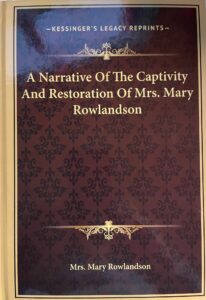 A famous one, A Narrative of The Captivity And Restoration of Mrs. Mary Rowlandson launched the genre. How is this Gothic? Some Gothic tropes: “The dark other.” “Things lurking in the scary wilderness.” If you are up for a horrible and despicable example of Gothic tropes, watch the 2015 movie, The Witch. (Yes, that was on our syllabus.)
A famous one, A Narrative of The Captivity And Restoration of Mrs. Mary Rowlandson launched the genre. How is this Gothic? Some Gothic tropes: “The dark other.” “Things lurking in the scary wilderness.” If you are up for a horrible and despicable example of Gothic tropes, watch the 2015 movie, The Witch. (Yes, that was on our syllabus.)
As the semester clicked on towards my seminar paper due date, I had to come up with something to defend. I began noodling: What happened to the captivity narrative after we decimated the Indians? The captivity narrative morphed into marital captivity. A famous example is “The Yellow Wall Paper” by Charlotte Perkins Gilman. (Hate it. Google it if you are curious.) I took my seminar paper defense out to Prairie short stories where the wind became sinister and Gothic tropes abound. Sometimes depending on the author—male or female—women withered away from Prairie madness. Gothic tropes: the wind is sinister, the weather uncontrollable, and westward hallucinations on the horizon. With no exchange for ransom, I deduced that women captive on the Prairie had to create their own escape routes. The ones I identified are: 1. Wither and die in the wind after your husband escapes to a “job” somewhere else. 2. Kill your husband, baby and yourself. 3. Leave your husband. 4. Overcome the elements and survive a heroine. I got an A in the class, and my professor says he’ll point me in more directions to abolish my “passive writing” and coach me on how to create a conference and submission-worthy paper. I plan to take him up on it.
 Finally—What I am reading and why…
Finally—What I am reading and why…
At the moment I can’t focus and have my nose in several books.
I love Natalie Goldberg. I’ve met her several times, and had occasion to run and get her a pen at Powell’s in Portland, Oregon in 2004 at her book signing. She’s funny with a wry sense of humor. Her book, Writing Down the Bones was the first book I read about writing. I am reading Three Simple Lines to understand Haiku. In the book jacket it says: “Natalie Goldberg is a delightful companionable tour guide into this world. She highlights the history of the form, dating back to the seventeenth century; shows why masters such as Basho and Issa are so revered… She also experiences and allows readers to share in the spontaneous and profound moments of enlightenment and awakening that haiku promises.” I read haikus from this book and others in my writing workshops. Haikus cut to the essence in nature and life. They inspire small moments, contemplation, and my writing.
Last year I became an Ada Limon groupie on Zoom. I saw her read and converse with poet Jennifer L. Knox at a Zoom presentation hosted by Writers@Grinell. I attended (on Zoom) the Writing by Writers Boulder Generative Workshop with Ada, Pam Houston and Dorothy Allison, and recently I saw Ada at a SOMOS-Taos Zoom event. I could sit and listen to Ada read her poems all day. She writes with a lyrical genius about the rawness of life and the sting of grief. Her writing is real and precise, and a lesson for me about the melody of words.
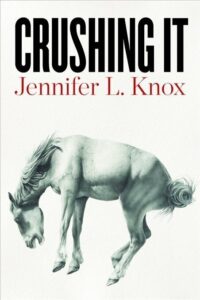 If you follow me on Facebook, you might have read my recent post about my poem “Shooting the Curl” which is one of the poems in Telepoem Booth® Iowa. Jennifer L. Knox taught the first graduate poetry class I took in my MFA Program at Iowa State. “Write a rant poem,” Jen said one night. I’d recently moved back to Iowa and man did I have a rant about hair-stylist trauma in Iowa. Jen’s poetry has been published in The New Yorker and the Best American Poetry 2020 to name a few of many publications. Jen. Does. Not. Mince. Words. The New York Times says, “Death, she reminds the reader, is everywhere, and it’s going to get us all. That reminder becomes a bizarre relief, spoken by a brilliantly blunt poet whose subtle pleasures cannot—and should not—be ignored.” Crushing It is Jen’s latest collection. As a writer, I read her work to better understand how to ground and surprise the reader, and how to surprise myself. You will be thrilled and surprised reading Jen’s poetry.
If you follow me on Facebook, you might have read my recent post about my poem “Shooting the Curl” which is one of the poems in Telepoem Booth® Iowa. Jennifer L. Knox taught the first graduate poetry class I took in my MFA Program at Iowa State. “Write a rant poem,” Jen said one night. I’d recently moved back to Iowa and man did I have a rant about hair-stylist trauma in Iowa. Jen’s poetry has been published in The New Yorker and the Best American Poetry 2020 to name a few of many publications. Jen. Does. Not. Mince. Words. The New York Times says, “Death, she reminds the reader, is everywhere, and it’s going to get us all. That reminder becomes a bizarre relief, spoken by a brilliantly blunt poet whose subtle pleasures cannot—and should not—be ignored.” Crushing It is Jen’s latest collection. As a writer, I read her work to better understand how to ground and surprise the reader, and how to surprise myself. You will be thrilled and surprised reading Jen’s poetry.
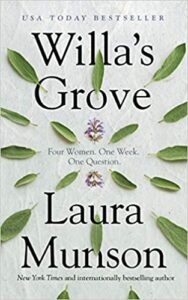 Laura Munson doesn’t know it, but she’s one of my literary heroines because she does not give up on writing dreams. At the recommendation of an author I met at a Dani Shapiro writing retreat, I set off in fall 2014 to attend Laura’s Haven Writing Retreat in Montana. I was drawn to her because of her bestselling memoir, This Is Not The Story You Think It Is. I was working on another draft of my memoir at the time—the same one I’m nearing completion on now. Twenty-two years in the writing my memoir. Laura had a dream about publishing her novel when I met her. I wanted her to write another memoir. Recently I watched her and Terry Tempest Williams on Zoom discuss Willa’s Grove. My copy arrived this week from the bookstore that hosted the event, and I can’t put it down. The novel is inspired by the power of women and friendship, and the question, “so what now?” So what now, is where I find myself nearing the end of my MFA Program, having recently turned 60. I can’t wait to see how the lives of the four women who spend a week together in Willa’s Grove are transformed.
Laura Munson doesn’t know it, but she’s one of my literary heroines because she does not give up on writing dreams. At the recommendation of an author I met at a Dani Shapiro writing retreat, I set off in fall 2014 to attend Laura’s Haven Writing Retreat in Montana. I was drawn to her because of her bestselling memoir, This Is Not The Story You Think It Is. I was working on another draft of my memoir at the time—the same one I’m nearing completion on now. Twenty-two years in the writing my memoir. Laura had a dream about publishing her novel when I met her. I wanted her to write another memoir. Recently I watched her and Terry Tempest Williams on Zoom discuss Willa’s Grove. My copy arrived this week from the bookstore that hosted the event, and I can’t put it down. The novel is inspired by the power of women and friendship, and the question, “so what now?” So what now, is where I find myself nearing the end of my MFA Program, having recently turned 60. I can’t wait to see how the lives of the four women who spend a week together in Willa’s Grove are transformed.
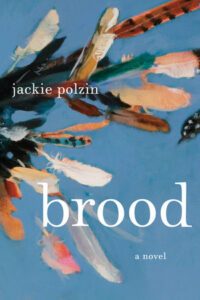 This book screamed at me to pick it up when I spied it on the table inside the door at Dog-Eared books on Main Street here in Ames, Iowa. Perhaps it was the colorful feathers that intrigued me? I picked it up and started reading it even though it said “novel” under the title. While writing my memoir, I’ve made habit of mostly reading memoirs and poetry collections to inform my writing. So I set the book down, walked around, left the story, came back, snatched up Brood, and bought it. I am savoring this book about chickens and their nameless narrator who tries to keep them alive during a brutal Minnesota winter, and over a course of a year. Reading Brood, I keep reminding myself that the voice is a fictitious voice. Or is it? I want this book to be a memoir because I want to meet the nameless narrator. The chapters are tight and short, and brilliant examples to use for my writing workshops where I teach my OLLI-ISU writers to write small so they can decide whether to write their personal stories bigger. Brood is Polzin’s first novel. It’s a gem, a joy, a meditation on life, refreshingly original.
This book screamed at me to pick it up when I spied it on the table inside the door at Dog-Eared books on Main Street here in Ames, Iowa. Perhaps it was the colorful feathers that intrigued me? I picked it up and started reading it even though it said “novel” under the title. While writing my memoir, I’ve made habit of mostly reading memoirs and poetry collections to inform my writing. So I set the book down, walked around, left the story, came back, snatched up Brood, and bought it. I am savoring this book about chickens and their nameless narrator who tries to keep them alive during a brutal Minnesota winter, and over a course of a year. Reading Brood, I keep reminding myself that the voice is a fictitious voice. Or is it? I want this book to be a memoir because I want to meet the nameless narrator. The chapters are tight and short, and brilliant examples to use for my writing workshops where I teach my OLLI-ISU writers to write small so they can decide whether to write their personal stories bigger. Brood is Polzin’s first novel. It’s a gem, a joy, a meditation on life, refreshingly original.



